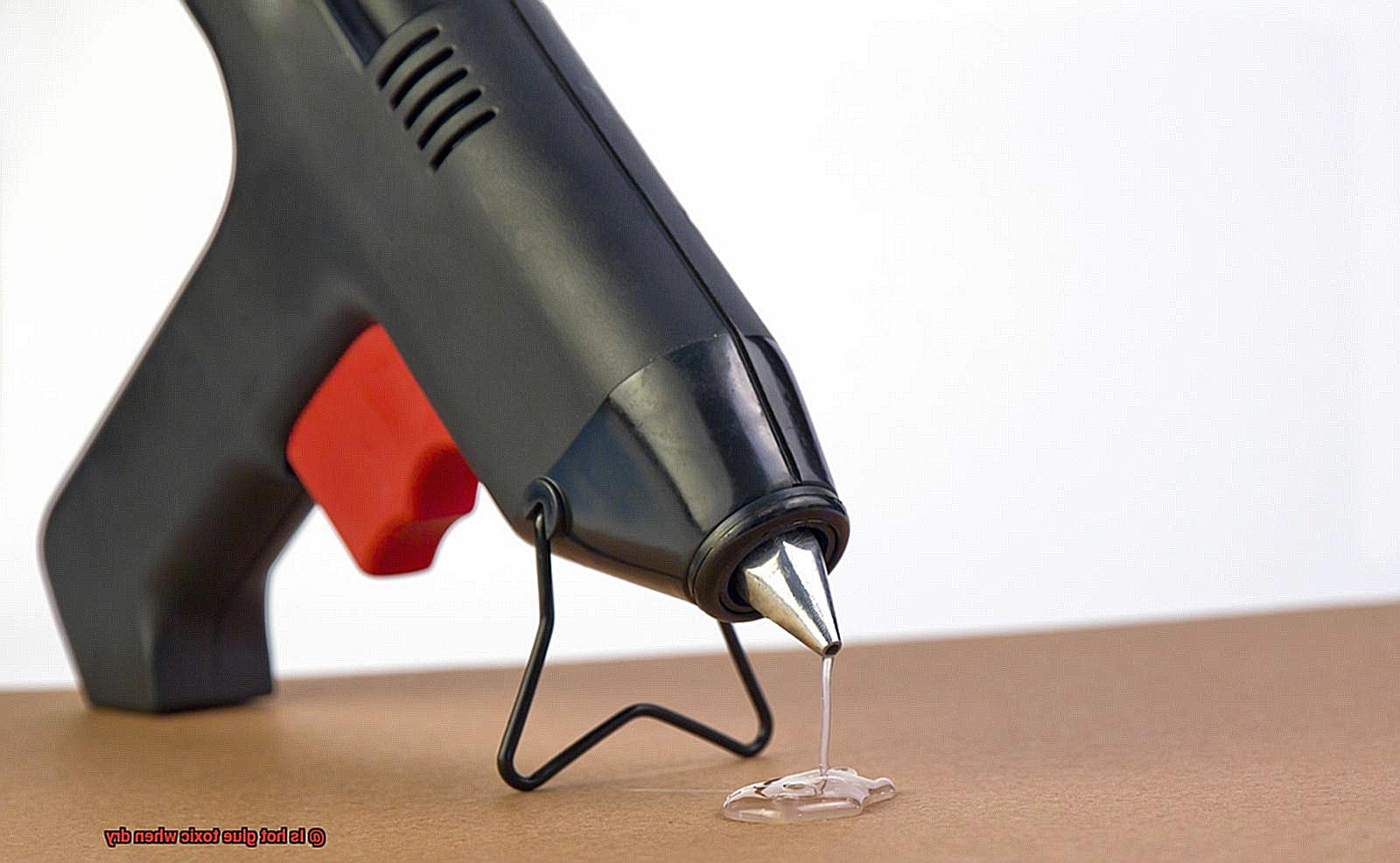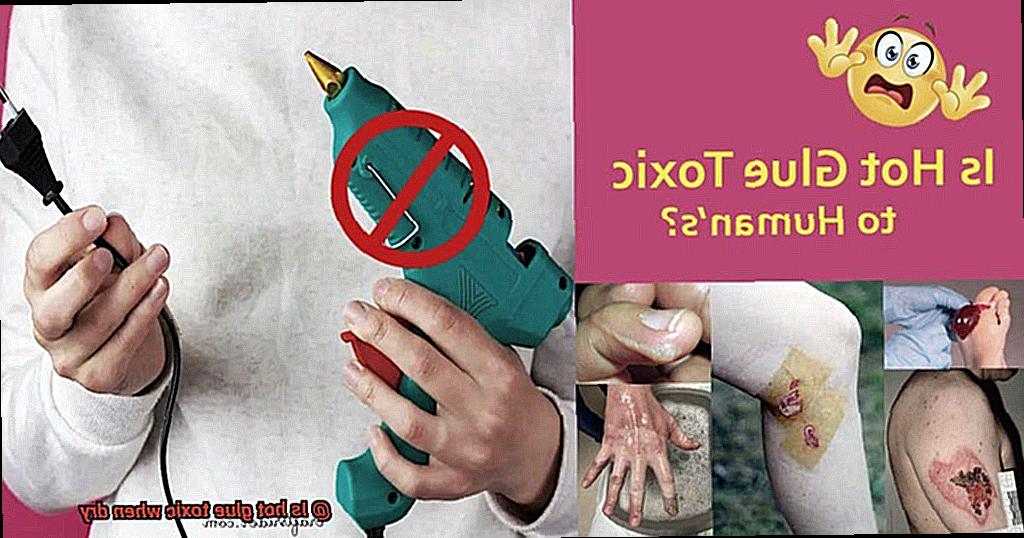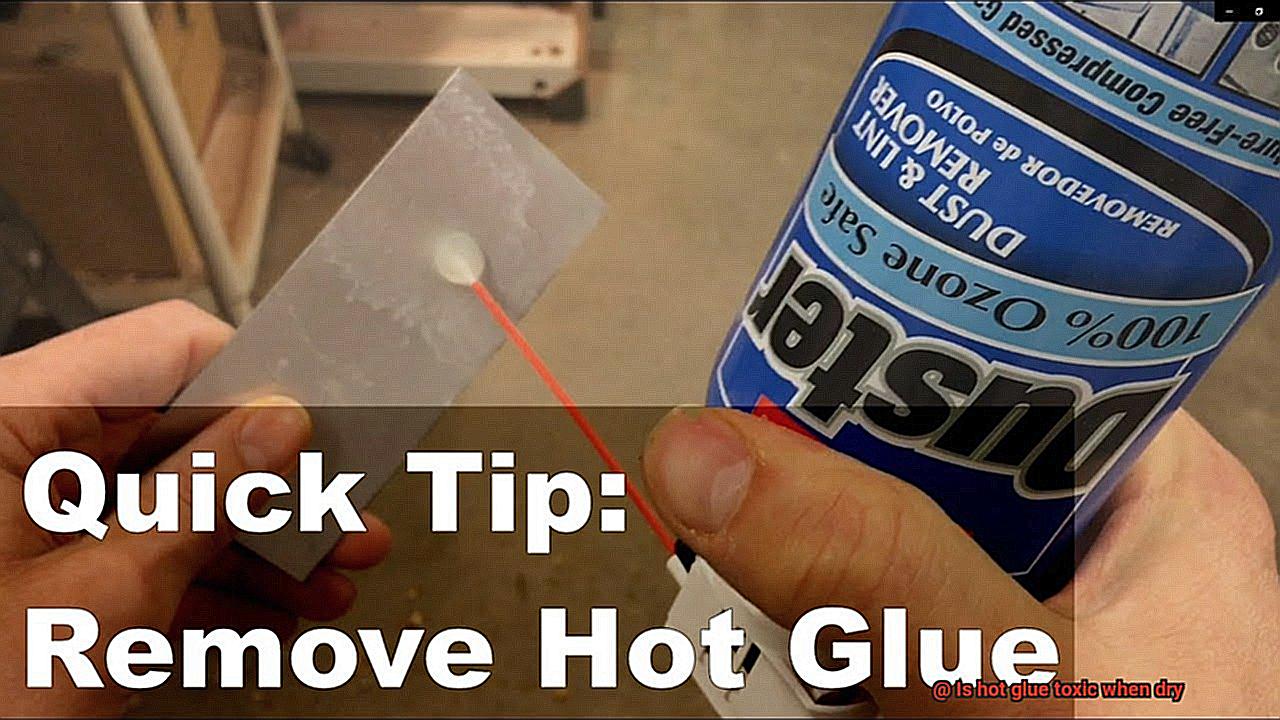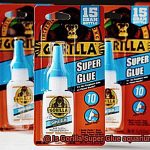Hot glue guns have always been the trusty sidekick of crafters, DIY enthusiasts, and hobbyists. With its versatility, easy application, and quick drying time, it’s no wonder hot glue is a go-to adhesive for various projects. However, amidst the buzz surrounding its effectiveness, questions about its safety and toxicity linger.
In this blog post, we embark on a journey to unravel the mystery: Is hot glue toxic when dry? Brace yourself as we separate fact from fiction, uncover potential risks associated with hot glue usage, and equip you with the knowledge needed to make informed decisions.
Understanding the Drying Process:
Contents
- 0.1 Understanding the Drying Process:
- 0.2 Potential Dangers:
- 0.3 Toxicity Levels and Precautions:
- 0.4 Conclusion:
- 1 What is Hot Glue?
- 2 Potential Hazards of Hot Glue in Liquid State
- 3 Is Hot Glue Toxic When Dry?
- 4 Main Components of Hot Glue
- 5 Choosing High-Quality Hot Glue Sticks
- 6 Other Factors to Consider when Working with Hot Glue
- 7 Safety Precautions for Handling Hot Glue Guns
- 8 Conclusion
Let’s start by peering into the fascinating process of hot glue drying. When expelled from a hot glue gun, the adhesive emerges as a scorching liquid. As it cools down, it solidifies into a robust bond that sticks to surfaces like magic. During this transformation, most volatile organic compounds (VOCs) found in hot glue evaporate into thin air, significantly reducing its toxicity.
Potential Dangers:
Nevertheless, caution should be exercised when handling hot glue. Avoid direct contact with your skin during application to prevent nasty burns. Furthermore, beware of fumes emitted during drying – especially in poorly ventilated areas – as they may irritate your respiratory system and eyes. These fumes are typically caused by VOCs that vary depending on the specific composition of the glue.
Toxicity Levels and Precautions:
Once dry, however, hot glue poses minimal risk of toxicity. Most commercially available hot glue sticks are crafted from non-toxic materials such as ethylene-vinyl acetate (EVA) or polyethylene copolymer. Once cooled and hardened onto surfaces, these adhesives are considered relatively safe for both adults and children.
Nonetheless, it is wise to exercise caution by using hot glue in well-ventilated spaces, as poor ventilation can exacerbate the effects of fumes. If you have a heightened sensitivity to chemicals or respiratory issues, wearing a mask while working with hot glue offers an extra layer of protection.
Conclusion:
In conclusion, dry hot glue poses minimal risk of toxicity. While certain precautions should be taken during application – like avoiding skin contact – any potential dangers associated with hot glue are greatly reduced once it has dried. So fear not, fellow crafters and DIY enthusiasts, and let your creativity flow with the knowledge that dry hot glue is
What is Hot Glue?
Hot glue, also known as hot melt adhesive, is a fiery force to be reckoned with in the world of adhesives. This versatile and widely used substance starts its journey as synthetic polymers, like ethylene-vinyl acetate (EVA) or polyamide, before being heated to a scorching temperature. As the polymers reach their boiling point, they transform into a molten or semi-liquid state, ready to take on any bonding challenge.

One of the alluring qualities of hot glue is its lightning-fast setting time. While other adhesives require an agonizing wait for curing or drying, hot glue solidifies within seconds to minutes, working its magic in record time. It fearlessly adheres to an array of materials, embracing wood, fabric, plastic, metal, and even glass in its heated embrace.
Hot glue comes in an assortment of forms, each catering to different needs and preferences. Whether it’s sticks, pellets, or cartridges for industrial use, there’s a sizzling solution for every adhesive adventure. And let’s not forget about the color spectrum – hot glue can be translucent or clear, allowing for seamless blending into various projects. Some formulations even possess superpowers like flexibility or low-temperature resistance, making them unstoppable forces in the adhesive realm.
Once hot glue dries, it becomes a formidable force that binds surfaces with an iron grip. Its strength and tenacity make it a go-to choice for craft enthusiasts, DIY warriors, woodworking maestros, and even industrial stalwarts in the automotive industry. It is a true champion in the realm of bonding.

But safety always takes center stage when it comes to wielding this fiery friend. While hot glue is generally safe and non-toxic after cooling and hardening completely, it requires careful handling and proper ventilation. Some hot glues may contain additives or chemicals that could pose a threat if ingested or inhaled. To ensure a secure journey with hot glue, it is vital to read and follow the manufacturer’s instructions and select high-quality sticks from reputable sources. And let’s not forget about handling hot glue guns with the utmost care to avoid burns or injuries.
Potential Hazards of Hot Glue in Liquid State
Hot glue, in its liquid state, can pose several potential hazards that one should be aware of. These hazards include burns, spills and splatters, respiratory hazards, and adhesive properties.
Firstly, the high temperatures at which hot glue is melted can cause severe burns if it comes into contact with the skin. The melted glue should be handled with caution and protective gloves should be worn to prevent burns.

Secondly, the low viscosity of hot glue in its liquid state makes it easy to accidentally spill or splatter onto nearby surfaces or objects. This can result in damage to furniture, fabrics, or other materials, as well as potential injury if the hot glue comes into contact with skin. It is important to work on a protected surface and be mindful of where the glue is being applied.
Furthermore, when hot glue is heated, it releases fumes that can be harmful if inhaled in excessive amounts. These fumes contain volatile organic compounds (VOCs) that can irritate the respiratory tract and cause symptoms such as coughing, wheezing, or shortness of breath. It is crucial to work in a well-ventilated area or use respiratory protection to minimize exposure to these fumes.
Lastly, hot glue quickly solidifies and forms a strong bond once applied. While this is desirable for its intended purpose, it can pose risks if not used properly. Accidental contact with the skin can cause painful removal or tearing of the skin when attempting to separate the glued surfaces.
To ensure safety when working with hot glue in its liquid state, it is important to take appropriate precautions. These include wearing protective gloves, working in a well-ventilated area, using a protected surface to prevent accidental spills, and following the manufacturer’s instructions and safety guidelines.
Is Hot Glue Toxic When Dry?
Let’s delve into the topic and determine if hot glue is toxic when dry.
To comprehend the potential toxicity of dried hot glue, we must examine its composition. Hot glue consists of thermoplastic polymers like ethylene-vinyl acetate (EVA) or polyurethane. These polymers solidify when cooled, forming a robust bond that withstands the test of time.
During the drying process, hot glue undergoes polymerization, where it forms long chains of molecules resulting in a solid material. Some chemical compounds may be released during this process, causing concern about toxicity. However, rest assured that these compound releases are generally minimal and considered harmless.
One group of compounds potentially emitted during hot glue polymerization is volatile organic compounds (VOCs). VOCs are chemicals that vaporize at room temperature and can contribute to indoor air pollution. Hot glue contains common VOCs such as formaldehyde and acetic acid. Thankfully, the levels of VOCs released from hot glue are usually low and well below the threshold for any significant health effects.
Concerning skin contact with dried hot glue, it typically poses no adverse reactions. However, take care to avoid burns when applying hot glue directly to the skin due to its high temperature. Once cooled and solidified, hot glue forms an inert substance unlikely to cause toxicity.
While hot glue is not intended for ingestion, accidental ingestion can occur. Consuming small amounts of dried hot glue is generally safe as it passes through the digestive system harmlessly. However, ingesting large quantities or doing so regularly may lead to digestive issues or blockages.
Inhalation of dried hot glue fumes is also a concern for some individuals. Nevertheless, the minimal release of VOCs during the drying process makes it unlikely for these fumes to cause significant harm. To minimize exposure to potentially irritating fumes, it is advisable to use hot glue in a well-ventilated area.
Main Components of Hot Glue
Hot glue, the versatile adhesive known for its strong bonding capabilities and quick drying time, has become an essential tool in the world of crafting, DIY projects, and industrial applications. However, concerns about its toxicity when dry have left many questioning its safety. To shed light on this matter, it is crucial to delve into the main components that make up hot glue.
At the core of hot glue lies a thermoplastic polymer, often referred to as a base resin. This resin, crafted from a combination of synthetic materials like ethylene vinyl acetate (EVA), polyethylene, or polypropylene, possesses a unique property – the ability to melt at high temperatures (around 350°F or 177°C) and solidify rapidly upon cooling.
To facilitate the melting process, hot glue sticks are infused with additives such as waxes or tackifiers. These remarkable constituents serve a dual purpose. Firstly, they decrease the viscosity of the resin, allowing it to flow seamlessly through the glue gun’s heating element. Secondly, they enhance the adhesive properties of the glue by improving its tackiness and flexibility.
Moreover, hot glue sticks often incorporate fillers to amplify specific characteristics. For instance, glass fibers or mineral fillers may be introduced to augment the strength and stiffness of the adhesive. Conversely, plasticizers may be included to enhance the flexibility and elongation properties of the dried glue.
It is important to note that most commercially available hot glue sticks are generally considered non-toxic when used as intended. These sticks are designed for general-purpose applications and can be safely employed on various surfaces such as paper, fabric, wood, and plastic. However, it is imperative to use hot glue in a well-ventilated area to avoid inhaling any potential fumes that may be emitted during the melting process.
In rare cases, individuals may experience mild allergic reactions or skin irritations upon contact with hot glue. These reactions can be attributed to sensitivities or allergies to certain components in the adhesive. If you have a known sensitivity or experience any adverse reactions, it is advisable to wear gloves or take necessary precautions to minimize skin contact.
Choosing High-Quality Hot Glue Sticks
Choosing high-quality hot glue sticks is crucial for the success of your projects. The right adhesive can make the difference between a strong, durable bond and a flimsy, temporary one. Here are some factors to consider when selecting hot glue sticks:
- Type of adhesive: Hot glue sticks are typically made from either synthetic resin or natural resin. Synthetic resin sticks offer a stronger bond and better resistance to heat and moisture, making them ideal for projects that require durability. Natural resin sticks, on the other hand, are biodegradable and environmentally friendly, making them a great choice for eco-conscious crafters.
- Temperature range: Different projects require different levels of heat resistance. Ensure that the hot glue sticks you choose can withstand the temperatures needed for your specific application. High-quality sticks will have a wide temperature range, providing versatility for various projects.
- Drying time: Consider the drying time of the glue sticks. Some projects may require quick-drying adhesives, while others may allow for longer drying times. High-quality glue sticks strike a balance between efficient bonding and maneuverability during application.
- Size and diameter: Check if the hot glue sticks you choose are compatible with your glue gun. Different glue guns require specific sizes of hot glue sticks. Additionally, the diameter of the stick can affect adhesive flow and quantity dispensed, so choose the appropriate size for your project.
- Brand reputation and reviews: Research reputable brands with positive customer feedback. Brands with a track record of producing high-quality products are more likely to offer reliable hot glue sticks.
Other Factors to Consider when Working with Hot Glue
Working with hot glue requires careful consideration of various factors to ensure both safety and successful results. One crucial factor is the temperature of the glue. Hot glue guns can reach scorching temperatures, surpassing 200 degrees Celsius (392 degrees Fahrenheit). Mishandling the gun can lead to severe burns, making it imperative to exercise caution and keep the tool away from your skin and flammable materials.
Bonding strength is another significant factor to ponder when using hot glue. While hot glue is renowned for its robust adhesion, it may not be suitable for all materials or applications. Surfaces like glass or metal, for instance, pose challenges as hot glue may struggle to provide a secure bond. Additionally, extreme temperatures or heavy loads can compromise the adhesive’s holding power. Thus, it is essential to assess your project’s specific requirements and select an appropriate adhesive accordingly.
The drying time of hot glue is also a consideration. Typically, hot glue dries relatively quickly, often within minutes. However, thicker applications may necessitate more time to dry thoroughly. To ensure a secure bond, it is crucial to allow sufficient drying time before handling or moving glued objects.
Flexibility and longevity are other factors that warrant attention. While hot glue offers a strong initial bond, it may lack the flexibility found in other adhesives like epoxy or silicone. Consequently, it may not be suitable for applications requiring flexibility, such as crafts involving fabrics. Additionally, over time, hot glue can become brittle and lose its adhesive properties, especially when exposed to extreme temperatures or prolonged sunlight.
Proper ventilation is vital when working with hot glue. Although hot glue itself does not release toxic fumes, the heating process can generate a slight odor and emit small amounts of volatile organic compounds (VOCs). While these VOCs are generally harmless in small quantities, it is advisable to work in a well-ventilated area to minimize any potential respiratory irritation.
Safety Precautions for Handling Hot Glue Guns
When it comes to handling hot glue guns, safety should always be a top priority. These powerful tools can reach temperatures between 200 to 400 degrees Fahrenheit, which means that a momentary lapse in judgment can result in painful burns or other injuries. To ensure you stay safe while working with hot glue, here are some important safety precautions to consider:
- Read the instructions: Before using a hot glue gun, take the time to read and understand the manufacturer’s instructions and warnings. This will provide valuable information on how to use the tool safely and prevent accidents.
- Wear protective gloves: Hot glue guns can cause severe burns if they come into contact with your skin. Therefore, it is crucial to wear heat-resistant gloves, such as those made from silicone or Kevlar, to protect your hands from accidental contact with the hot glue.
- Protect your eyes: Hot glue can splatter or drip, and even a small amount can cause severe burns if it gets into your eyes. To prevent this, always wear safety glasses or goggles to shield your eyes from any potential accidents.
- Work in a well-ventilated area: Hot glue releases fumes when heated, and inhaling these fumes for an extended period can be harmful. To ensure your safety, work in a well-ventilated area by opening windows or using a fan to improve air circulation.
- Use a stable surface: When not in use, make sure to place the hot glue gun on a stable and heat-resistant surface. A dedicated glue gun stand or a ceramic tile can be used for this purpose. This will prevent accidental fires or damage to surfaces.
- Avoid touching the nozzle: The nozzle of a hot glue gun can remain extremely hot for several minutes after use. Never touch the nozzle or any other part of the gun while it is in use or immediately after use to avoid severe burns.
- Allow the gun to cool down: After finishing with a hot glue gun, always unplug it and allow it to cool down completely before storing it. This prevents accidental burns or fires caused by contact with a still-hot tool.
- Seek medical attention for burns: If you sustain any burns or injuries while using a hot glue gun, it is important to seek immediate medical attention. Run cold water over the burn for several minutes and cover it with a clean cloth or bandage until help arrives.
- Keep it away from children and pets: Hot glue guns are not toys and should be kept out of reach of children and pets. The high temperatures and potential for burns make them dangerous if mishandled or used improperly.
- Store properly: When not in use, store the hot glue gun in a safe place where it is not easily accessible to children or pets. This will prevent any accidental injuries or misuse.
Conclusion
In conclusion, it’s reassuring to know that hot glue is generally safe and non-toxic once it’s dry. As the glue dries, those pesky volatile organic compounds (VOCs) that might cause concern evaporate into thin air, significantly reducing any potential toxicity. So you can breathe a sigh of relief.
But don’t get too complacent just yet. It’s still important to exercise caution when working with hot glue. The last thing you want is to experience the fiery sting of a burn on your precious skin. So keep your hands away from that scorching glue like it’s a sizzling pan on the stove.
And let’s not forget about those fumes that can make your eyes water and your lungs feel like they’re in a smoggy city. In poorly ventilated areas, those drying fumes might irritate your respiratory system and delicate peepers. So be smart and use hot glue in a well-ventilated space or slap on a mask for some extra protection.
When it comes to choosing your hot glue sticks, don’t settle for anything less than top-notch quality from trustworthy brands. You want sticks that can handle the heat, dry quickly, fit snugly in your glue gun, and come highly recommended by satisfied customers. Don’t skimp on quality when it comes to adhesive artistry.
So here’s the bottom line: take sensible precautions, work in a space where fresh air flows freely, and you’ll be able to unleash your creative genius without worrying about toxic troubles.






